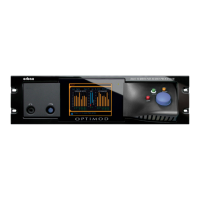3-8
OPERATION ORBAN MODEL 8685
• as close as possible to the input at all times (using the Two-Band Protection Lim-
iter preset)
• open but more uniform in frequency balance (and often more dramatic) than
the input (using the Two-Band structure or running the Five-Band Structure with
slow release time)
• dense, quite squashed, and very loud (using the Five-Band Structure with faster
release times)
The dense, loud setup will make the audio seem to jump out of car and table audio
systems but may be fatiguing and invite tune-outs on higher quality home receivers.
The loudness/distortion trade-off explained above applies to any of these setups.
In professional broadcasting environments, you will achieve best results if Engineer-
ing, Programming, and Management go out of their way to communicate and co-
operate with each other. It is important that Engineering understand the sound that
Programming desires, and that Management fully understands the trade-offs in-
volved in optimizing one parameter (like loudness) at the expense of others (like
distortion or excessive density).
Never lose sight of the fact that, while listeners can easily control loudness, they
cannot make a distorted signal clean again. If such excessive processing is permitted
to audibly degrade the sound of the original program material, the signal is irrevo-
cably contaminated and the original quality can never be recovered.
About the 8685’s Signal Processing Features
Simultaneous Stereo (2.0) and Surround (5.1 or 7.1) Processing
The 8685 can process stereo and surround programming. There are four stereo
processors and one surround processor available for use simultaneously.
You can set the processing parameters for the stereo and surround processors inde-
pendently. The output of each stereo processor can be applied to its own look-
ahead limiters and the output of these can be routed to the hardware output speci-
fied in the 8685’s output routing switcher. Alternatively, the output of stereo proces-
sor #1’s multiband compressor and Loudness Controller can be mixed with the LF
and RF surround signals immediately before the surround processing’s LF and RF
look-ahead limiters. The first scenario allows you to use the 8685 as five independ-
ent processors.
The 2.0 processing is similar to Orban’s Optimod 6300 except that the 6300’s stereo
enhancer is omitted in the 8685. (For example, you might use 2.0 processing to drive
a low bitrate netcast or ATSC subchannel(s).) The second scenario allows separate
processing of locally originated 2.0 material before it is mixed with (for example) a
surround feed from your affiliated network.

